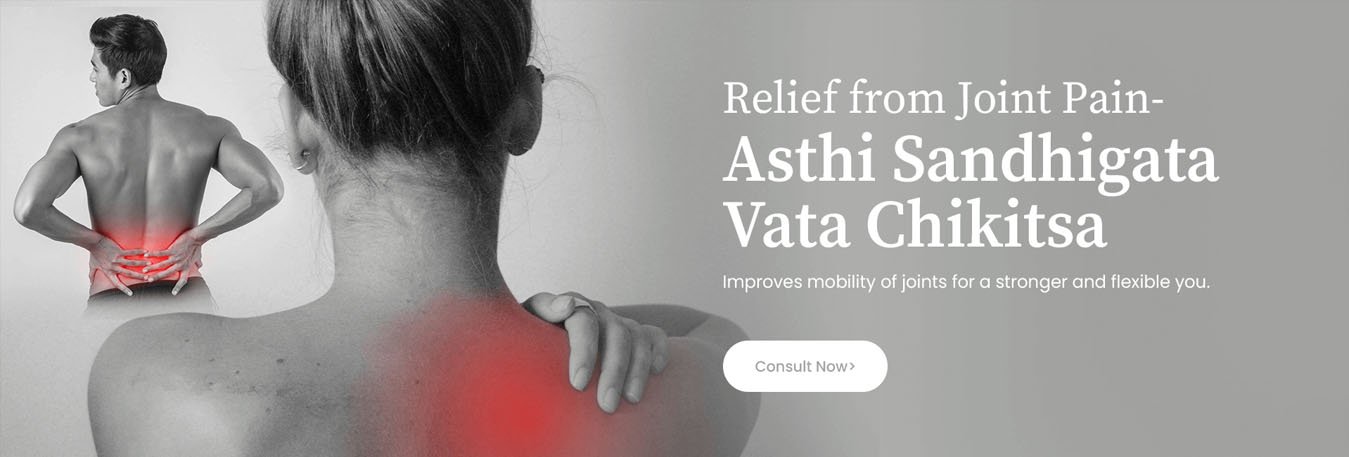Asthi Sandhigata Vata Chikitsa: Ayurveda’s Solution for Spine & Joint Care

In Ayurveda, spine and joint disorders are often seen as the result of imbalances in the doshas—Vata, Pitta, and Kapha—and the accumulation of toxins in the body. At Adyant Ayurveda, the leading Ayurvedic hospital in Bangalore, we specialize in restoring balance to these doshas, eliminating toxins, reducing inflammation, and strengthening the joints to promote overall spinal health.
This article explores common spine and joint disorders, their causes, and how Ayurvedic treatments can naturally help.
For a free consultation with top ayurvedic doctors for Spine and Joint Care Ayurvedic Treatment, download our app from Play Store “AyurCare“
What is Spine Disorder?
Spine disorders refer to conditions that affect the spinal cord, located within the vertebral column. The vertebrae protect the spinal cord, which is responsible for transmitting messages from the brain to various body parts. The spine has four distinct sections:
- Cervical (neck)
- Lumbar (upper back)
- Thoracic (middle back)
- Sacral (pelvis)
Spinal disorders can range from mild discomfort to severe pain and may include conditions such as herniated discs, fractures, and degenerative diseases, often limiting movement.
You May Like Also: Ayurvedic Treatment for Cervical Spondylosis
Common Causes of Spine Disorders
- Trauma: Injuries from accidents or falls
- Herniated Discs: When the inner core of a spinal disc protrudes and irritates surrounding nerves
- Degenerative Diseases: Age-related wear and tear
- Infection: Spinal infections can affect the vertebrae and surrounding tissues
- Tumors & Cysts: Abnormal growths on or near the spine
- Inflammation & Genetic Factors: Conditions like Ankylosing Spondylitis or inherited disorders
Read Also: Ayurvedic Treatment for Disc Bulge
Types of Spine Disorders
1. Degenerative Spine Conditions:
- Arthritis
- Spondylosis
- Herniated Disc
- Spinal Stenosis
2. Other Conditions:
- Ankylosing Spondylitis
- Osteoporosis & Fractures
- Scoliosis
- Radiculopathy
Signs and Symptoms of Spine Disorders
- Back pain (sharp, dull, or burning)
- Weakness, numbness, or tingling in the limbs
- Paralysis or loss of movement
- Nausea or vomiting
- Loss of reflexes
- Muscle spasms or tightness
- Loss of bowel or urinary control
What is Joint Disorder?
Joint disorders involve damage or inflammation of the joints, tendons, ligaments, and cartilage. These conditions impact the body’s range of motion and can lead to pain, swelling, and difficulty in movement.
Read Also: Ayurvedic Approach to Healing Knee Ligament and Meniscal Injuries
Common Joint Disorders:
- Osteoarthritis: Degeneration of cartilage due to aging or overuse
- Rheumatoid Arthritis: Autoimmune attack on joint linings
- Gout: Uric acid crystal buildup
- Bursitis: Inflammation of the fluid-filled sacs that cushion joints
Risk Factors for Spine and Joint Disorders
- Obesity: Increased weight strains joints and spine
- Poor Posture: Improper alignment can lead to wear and tear
- Sedentary Lifestyle: Lack of exercise weakens muscles and joints
- Injury or Trauma: Sports or accident-related injuries
- Aging: Natural degeneration of tissues over time
Ayurvedic Treatment for Spine & Joint Disorders
Ayurveda offers a holistic approach to treating spine and joint disorders by balancing the doshas and eliminating toxins from the body. Here’s how Ayurveda treats these conditions:
1. Abhyanga (Therapeutic Oil Massage)
Abhyanga is a full-body massage using warm, medicated oils tailored to the individual’s dosha imbalance. This treatment improves circulation, reduces muscle stiffness, and supports joint health.
2. Swedana (Herbal Steam Therapy)
Swedana involves applying herbal steam to the body, helping to detoxify the system, reduce inflammation, and relieve muscle tension. This therapy can be particularly beneficial for joint and spine pain.
3. Basti (Enema Therapy)
Basti is an Ayurvedic enema therapy using medicated oils or herbal decoctions. It helps nourish the spinal tissues, reduce inflammation, and alleviate pain.
4. Pinda Sweda (Herbal Poultice Therapy)
This involves applying warm herbal poultices to affected areas, especially the spine, to reduce pain, inflammation, and muscle spasms.
5. Masha Pinda Sweda
This unique therapy uses black gram (Masha) and medicinal herbs for fomentation. It strengthens muscles, reduces joint stiffness, and supports the overall health of bones, muscles, and tendons.
Panchakarma Treatments for Spine & Joint Health
Panchakarma is a comprehensive detoxification and rejuvenation therapy aimed at cleansing the body of accumulated toxins (Ama). Specific Panchakarma treatments for spine and joint health include:
1. Vaitarana Basti
This basti treatment is particularly effective for Vata disorders and conditions like rheumatoid arthritis. It helps alleviate pain, inflammation, and stiffness, improving joint function.
2. Shashtika Shali Pinda Sweda (Navarakizhi)
A revitalizing therapy that uses special rice processed with milk and herbal decoctions. This treatment strengthens the muscles, bones, and nerves, making it ideal for improving spinal and joint health.
3. Tiktha Ksheera Basti
An effective treatment for bone, joint, and nerve disorders, Tiktha Ksheera Basti combines medicated oils, milk, and ghee to nourish the affected areas, reduce inflammation, and enhance circulation.
Ayurvedic Herbs for Spine & Joint Disorders
Several Ayurvedic herbs play a crucial role in the treatment of spine and joint disorders by reducing inflammation, strengthening tissues, and supporting joint mobility. Some of these include:
- Shallaki (Boswellia serrata): Reduces joint pain and inflammation
- Guggulu: Improves joint mobility and reduces pain
- Ashwagandha: Strengthens bones and muscles
- Turmeric: Known for its anti-inflammatory properties
- Nirgundi: Relieves muscle and joint pain
- Triphala Guggulu: Detoxifies the body and relieves joint stiffness
Lifestyle and Dietary Recommendations for Joint & Spine Health
To maintain spine and joint health, Ayurveda also emphasizes the importance of a balanced lifestyle:
- Diet: A dosha-specific, anti-inflammatory diet is recommended. Incorporate foods that strengthen bones, such as calcium-rich foods and anti-inflammatory herbs.
- Exercise: Gentle yoga, stretching, and strengthening exercises improve flexibility and reduce stiffness.
- Posture: Maintain proper posture to prevent strain on the spine and joints.
Why Choose Adyant Ayurveda for Spine & Joint Disorders?
At Adyant Ayurveda, we combine traditional Ayurvedic therapies with personalized care to treat spine and joint disorders effectively. Our expert Ayurvedic practitioners use a combination of therapies tailored to your unique needs, ensuring a holistic approach to health and healing.
Whether you are suffering from chronic pain, stiffness, or limited mobility, our treatments, including Abhyanga, Panchakarma, and herbal therapies, provide long-term relief without the need for invasive procedures.
Ayurvedic Spine and Joint Treatment: Conclusion
Spinal and joint disorders can significantly impact your quality of life, but Ayurvedic treatments offer a natural and holistic way to restore balance and reduce symptoms. At Adyant Ayurveda, we are dedicated to providing personalized Ayurvedic solutions to promote spine and joint health. Through our Asthi Sandhigata Vata Chikitsa, we help alleviate pain, improve mobility, and rejuvenate the body.
For more information or to book a consultation, contact Adyant Ayurveda today.
FAQs on Ayurvedic Spine and Joint Treatment
How does Ayurveda treat spinal and joint disorders?
Ayurveda addresses spinal and joint disorders by restoring balance in the body, reducing inflammation, improving joint health, and alleviating pain. Treatment typically includes a combination of herbal remedies, dietary and lifestyle adjustments, Panchakarma therapies, and external treatments tailored to address the root causes of the condition.
What herbs are commonly used in Ayurveda for spinal and joint disorders?
Ayurveda utilizes several herbs to treat spinal and joint disorders, including:
- Shallaki (Boswellia serrata)
- Guggulu
- Ashwagandha
- Turmeric
- Nirgundi (Vitex negundo)
These herbs are renowned for their anti-inflammatory, analgesic, and rejuvenating properties, helping to reduce symptoms and enhance joint health.
Is Ayurveda effective for managing spinal and joint disorders?
Yes, Ayurveda can be effective in managing spinal and joint disorders by addressing their root causes and promoting overall well-being. The results vary based on individual factors, the severity of the condition, and treatment adherence. Consulting an experienced Ayurveda practitioner is recommended for personalized guidance.
How long does Ayurveda treatment take to show results?
The duration of Ayurveda treatment depends on factors such as the condition’s severity, individual response, and adherence to the prescribed regimen. Ayurveda is a gradual, holistic approach, and noticeable improvements may take weeks or months. Patience and consistency are essential for sustainable healing.
Can Ayurveda be used alongside conventional medical treatments?
Yes, Ayurveda can complement conventional treatments for spinal and joint disorders. It’s important to inform both your Ayurveda practitioner and healthcare provider about all treatments you’re receiving to ensure a safe, integrated approach to your care.
Are there any side effects with Ayurveda treatments?
Ayurveda treatments, when administered by a qualified practitioner, typically have minimal side effects. However, some individuals may experience mild reactions or allergies to certain herbs. It’s essential to disclose any known allergies or pre-existing conditions to ensure a safe and effective treatment plan.
Book Your Ayurvedic Thyroid Treatment Consultation Today! Call +91-99725-41009 or visit adyantayurveda.com.


